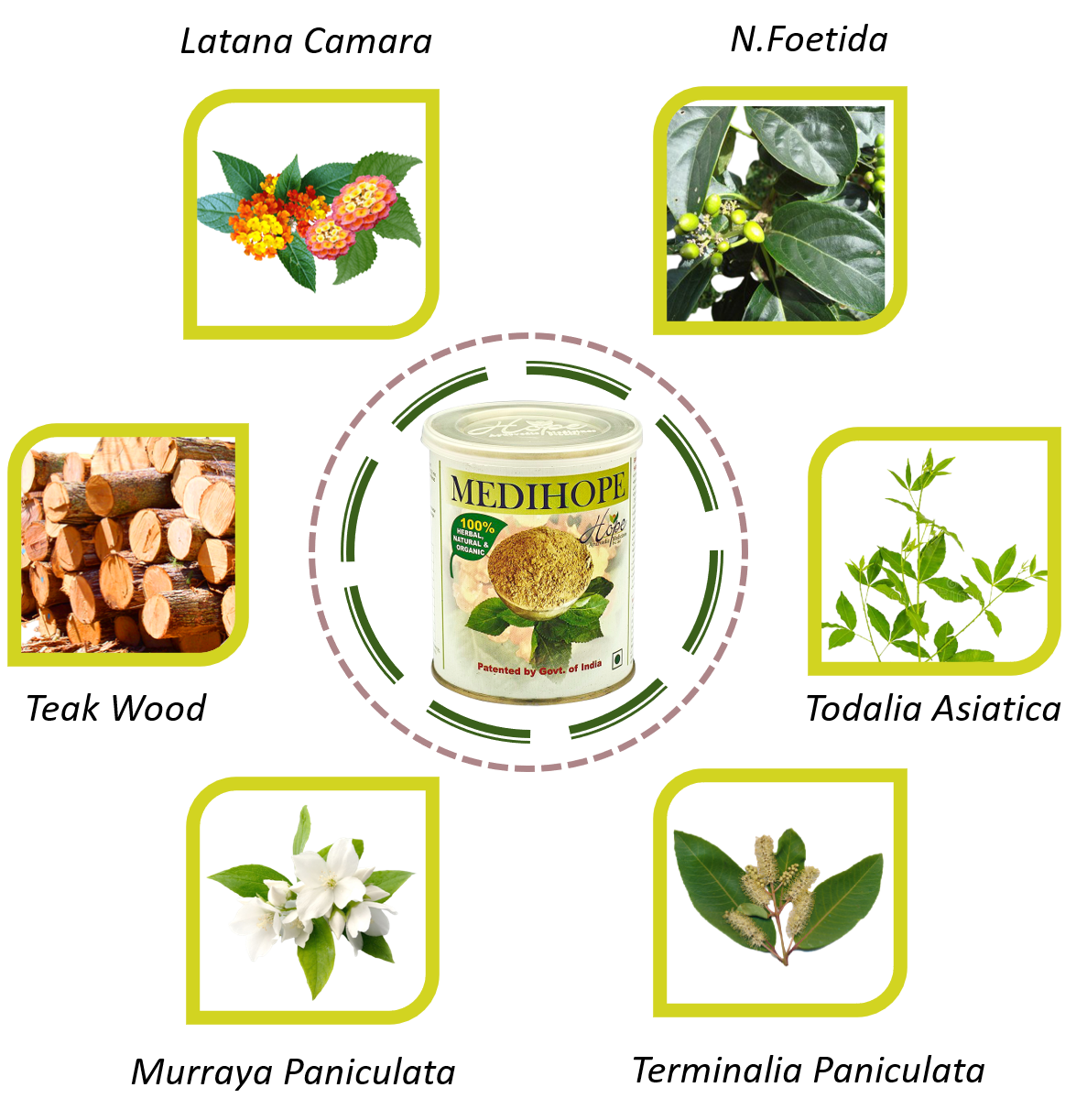
Our Patented MEDIHOPE™️ Formula
Our key 6 herbs work in synergy to provide a potent mixture
-

Latana Camara-35%
Studies conducted in India have found that Lantana leaves can display antimicrobial, fungicidal and insecticidal properties. it has also been used in traditional herbal medicines for treating a variety of ailments, including blood related Disorders , skin itches, rabies, chicken pox, measles, Respiratory Diseases and ulcers.
-

Teak Wood-35%
Virtually every part of the teak tree has medicinal uses, and medical science has shown that the leaves have antibacterial, anti-ulcer and antifungal properties. In Ayurdeva the wood is considered a laxative, a sedative for the uterus, good for piles, dysentery.
-

Murraya Paniculata-10%
Paniculata leaves extract is orally used to alleviate pain. In the Philippines, leaves were also used to treat diarrhea and dysentery because of their stimulant and astringent activities. In India, people sometimes used root bark of M. paniculata as remedy for coughs, psychological Issues.
1
/
of
3
-

Terminalia Paniculata-10%
Internally, the bark powder is used in treating Temperature of body and diseases of Pitta and Kapha doshas. It reduces inflammation. Externally, It helps in Wound healing. It helps in faster healing of fractured bones. It acts as natural immunity booster.
-

Todalia Asiatica-05%
Toddalia asiatica is used medicinally by Venda herbalists. The fruit is used by the Massai as a cough remedy and the roots in the treatment of indigestion. The leaves are used for lung diseases.
-

N. Foetida-05%
It has been reported that extracts of N. foetida shows antibacterial activity. The methanol fractions were found to be most effective. Camptothecin can be used as antimalarial drug.
1
/
of
3

Our Patented MEDIHOPE-D™️ Formula
Our key 8 herbs work in synergy to provide a potent mixture
-

Salacia Reticulata-20%
Salacia reticulata (SR), commonly known as ‘Meharimula’ in which ‘mehari’ indicates sugar related problem. Its roots majorly contain compounds such as mangiferin, kotalanol and salacinol, which are mainly responsible for the hypoglycaemic action of the plant (Arunakumara & Subasinghe, 2010).
-

Pterocarpus Marsupium-20%
Pterocarpus Marsupium (PM), commonly known as Vijayasar has been used in Ayurveda for a long time. It has been used extensively since ancient times for treating sugar related problems. PM exhibits distinctive properties such as beta call protection and its regeneration thus resulting in lowering blood glucose levels.
-

Terminalia Bellirica-05%
Terminalia Bellirica (TB), commonly termed as ‘Beheda’ has been used in various traditional medicines since ancient times. Its fruit is traditionally used to treat diarrhoea, headache, hypertension, pain and inflammations.
-

Terminalia Chebula-05%
This plant famously known as Haritaki, is considered significant in ayurvedic, unani and siddha medicine because of its extensive medicinal benefits. Terminala chebula (Combretaceae) is called the “King of Medicines”.
1
/
of
4
-

Tinospora Cordifolia-10%
Commonly known as ‘Guduchi’ TC is considered an important medicinal plant in ayurvedic medicine. It exhibits anti-sugar properties by inhibiting gluconeogenesis and glycogenolysis by promoting insulin secretion.
-

Emblica Officinalis-20%
Commonly known Amla or Indian Gooseberry, EO has been significantly used in traditional medicinal systems such as ayurveda, unani, siddha and homeopathy for time immemorial. EO is one of the richest sources of Vitamin-C since ancient times.
-

Alstonia Scholaris-10%
Alstonia Scholaris (AS) popularly known as ‘Saptaparni’ or ‘Devil’s Tree’ has been used in ayurvedic and other traditional medicines in various disorders.
-

Syzygium Cumini-10%
Syzygium Cumini (SC), popularly known as ‘Jamun’ is one of the widely used medicinal plants in the treatment of various diseases in particular sugar related problems. Various studies have reported the anti-sugar activity of different parts of jamun in sugar animals.
1
/
of
4














